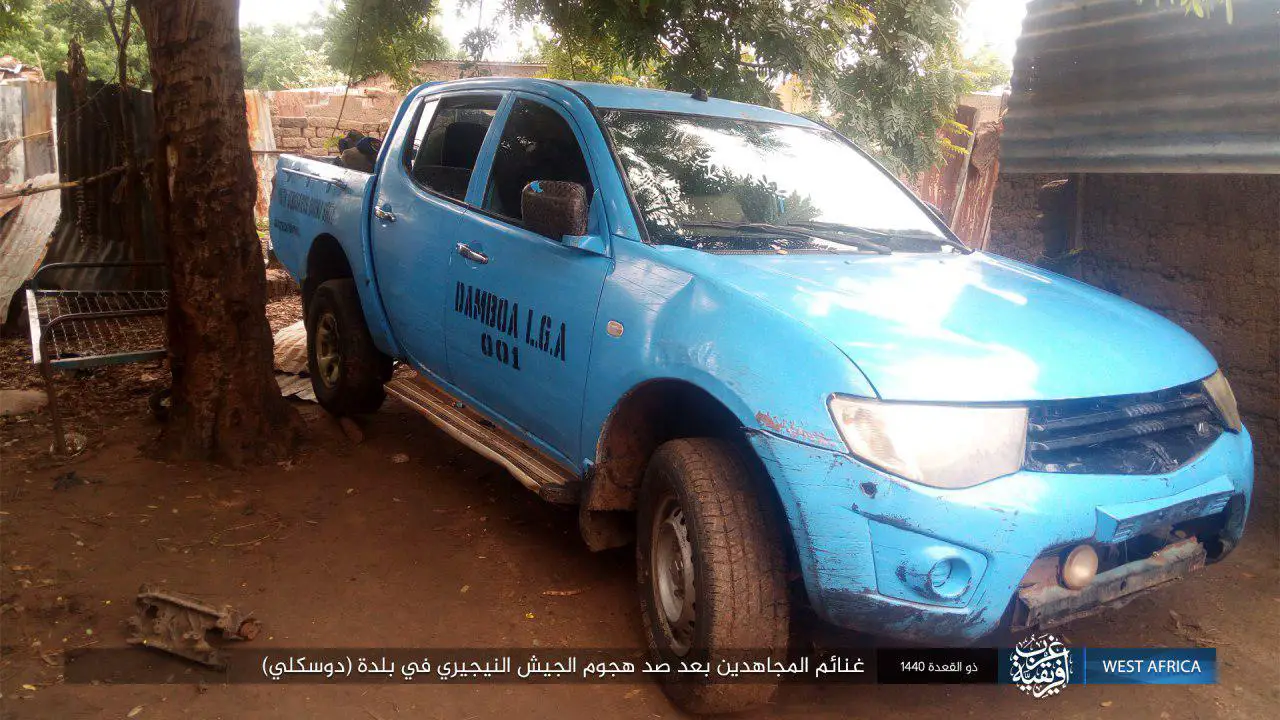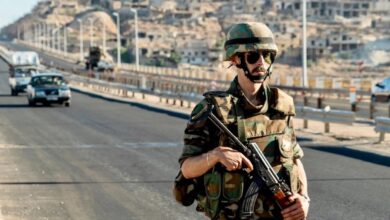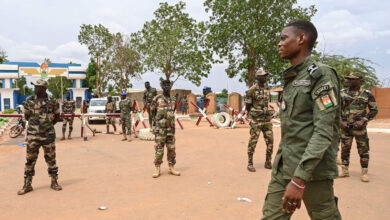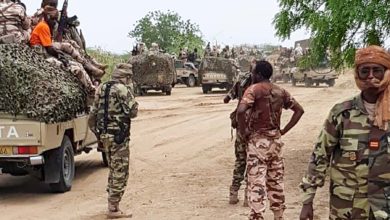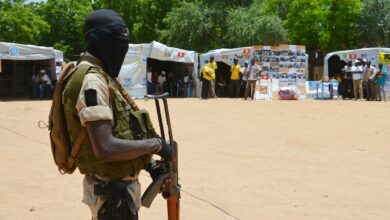Islamic State claimed fighters from its West Africa Province affiliate fought off a Nigerian military assault in the Damboa area last week, a part of Borno state that has seen an increasing amount of militant activity in recent months.
In a Sunday statement, ISIS said ISWAP fighters “were able to repel the attack by the Nigerian army” in a town it called “Duskali” in Borno state, “killing and injuring 25 of them.” It said weapons, ammunition and a four-wheel drive vehicle were captured.
ISIS propaganda agency Amaq on Sunday claimed the incident occurred on Thursday, July 4, and that “fierce clashes between the two sides lasted several hours and ended with the withdrawal of Nigerian soldiers.”

Later on Sunday, ISIS released images of four pickup trucks that it claimed its fighters had captured, as well as graphic images of three dead bodies, two in what appeared to be Nigerian army uniforms and one wearing civilian clothing.
One blue pickup truck pictured had “Damboa L.G.A. 001” painted on its side.
Damboa town, the headquarters of the Local Government Area, is around 85 km (53 miles) southwest of Borno state capital Maiduguri.
Polish open source analyst Tomasz Rolbiecki placed the incident in a village he called Dusala, in Damboa LGA, around 32 km (20 miles) northwest of Damboa town, but The Defense Post has been unable to confirm the name of the village.
Reuters reported a Thursday incident in the Damboa area on Sunday in which it said soldiers had attempted to clear a “Boko Haram camp” but were ambushed.
The commander of Sector 1, Operation Lafiya Dole, Brigadier-General Bulama Biu, confirmed there were clashes but said there were no military casualties, Reuters reported.
But three military sources and three Civilian Joint Task Force militia members told Reuters that five bodies had been recovered, 14 soldiers and two civilians were injured, and others were missing.
The Civilian JTF works alongside the Nigerian military against insurgent groups in northeastern Nigeria.
The Nigerian military seldom comments on the ongoing counter-insurgency operations, and tends to downplay the insurgents’ effectiveness, rarely acknowledging engagements and seemingly understating military casualties and equipment losses.
In one case, after ISWAP fighters in April attacked a Nigerian military base in Sabon Gari, between Damboa and near Biu, the Nigerian Army described reporting on the incident as “unsubstantiated” and “fake,” saying it was the work of “Boko Haram sympathizers.”
A month later on May 24, ISWAP fighters ambushed a convoy that was transporting civilians from Sabon Gari to Damboa. Media reported that between five and 25 Nigerian soldiers died in that attack, but again the Nigerian Army described those reports as “fake news” and denied there had been any attacks on military personnel in Borno state.
The civilians were being moved by the military at short notice to displacement camps in Damboa. The Nigerian army has in the past moved civilians from their homes ahead of military operations.
ISWAP in Nigeria
The jihadist group known as Boko Haram began its bloody insurgency in northeastern Nigeria in 2009, but it has since spread into neighboring Niger, Chad and Cameroon, prompting a regional military response. More than 27,000 people have been killed and two million others displaced, sparking a dire humanitarian crisis in the region. The U.S. assesses that Boko Haram and ISWAP have been responsible for over 35,000 deaths since 2011.
Boko Haram split into two factions in mid-2016. One, led by long-time leader Abubakar Shekau, is notorious for suicide bombings and indiscriminate killings of civilians. Shekau pledged allegiance to ISIS leader Abu Bakr Al-Baghdadi in March 2015, but ISIS central only gives formal backing to the other faction, which it calls Islamic State West Africa Province.
The ISWAP faction, which largely focuses on attacking military and government targets, was led by Abu Mus’ab Al-Barnawi, but in March, audio recordings revealed that ISIS appointed Abu Abdullah Idris bin Umar, also known as Ibn Umar al-Barnawi, as leader. Despite releasing several videos featuring ISWAP since, ISIS has not yet made a public statement confirming the change.
Since May, Islamic State has attributed insurgent activities in the Mali-Burkina Faso-Niger tri-border area to its West Africa Province affiliate, rather than to what was previously known as Islamic State in the Greater Sahara. In a June 15 ISIS propaganda video, ISWAP militants purportedly in Nigeria, Mali and Burkina Faso were shown reaffirming their pledge of allegiance to ISIS leader Baghdadi.
The regional counter-insurgency Multinational Joint Task Force which comprises personnel from Chad, Cameroon, Niger, and Nigeria, launched Operation Yancin Tafki on February 21 to battle the insurgents. It has said the cross-border operation is aimed at “making islands and other settlements in Lake Chad untenable for Boko Haram Terrorists.”

